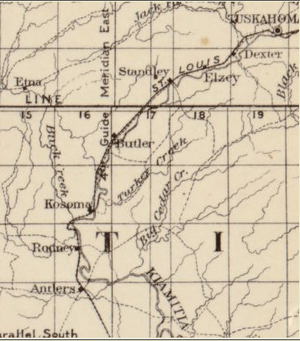Buck Creek (Kiamichi River tributary) facts for kids
Buck Creek is a stream in Pushmataha County, Oklahoma. It is about 38.9 miles (62.6 kilometers) long. The creek starts in the western Kiamichi Mountains and flows south. It eventually joins the Kiamichi River.
Where Buck Creek Flows
Buck Creek begins in southern Pittsburg County, Oklahoma. It then flows southwest into Atoka County, Oklahoma. The creek turns east and goes around Buck Creek Mountain. After that, it heads south into Pushmataha County.
The creek cuts through several "water gaps." These are narrow passages between mountains. For example, it flows between White Rock Mountain and Horsehead Mountain. It also passes between Parker Mountain and Little Mountain before joining the Kiamichi River.
Buck Creek is special because natural springs feed it along its whole path. This means it always has a steady flow of water, even when it's dry. For much of its journey, it flows through a narrow valley with steep, winding sides.
When there are heavy rains, Buck Creek can rise very quickly. This happens because many smaller streams and ravines flow into it. Its main smaller streams are Kimbrough, Little Kimbrough, and Horsehead creeks. You can also see amazing formations of large boulders, some as big as houses, along parts of the Buck Creek valley.
Buck Creek's History
Buck Creek played a small role during the American Civil War. In August 1864, it was a camp for Confederate soldiers. This camp was about 20 miles (32 kilometers) southwest of Fort Smith National Historic Site. A small event called "Marston's Skirmish" happened nearby. During this event, a few soldiers crossed the Arkansas River. They gathered information about Federal forces and captured some items before returning to camp.
After the 1880s, the area around Buck Creek began to develop. This was because the St. Louis-San Francisco Railway built tracks that crossed the creek. The Buck Creek valley became a route into the mountains. Loggers used it to transport timber. They built a special railroad, called a tram, up the creek valley. This tram carried cut timber down to the main railroad. However, floods often damaged the tram, and it was eventually closed.
Before Oklahoma State Highway 2 was built, crossing Buck Creek was difficult. People used a low-water crossing, but it was often unsafe. Floods or high water made it impossible to cross. The new highway, with its bridge over the creek, made travel much easier and safer.
Plans for Dams
In the past, the Oklahoma Water Resources Board thought about building a dam on Buck Creek. This dam would have helped control floods. However, these plans are not being considered anymore. Other dams, like those for Sardis Lake and Hugo Lake, were built on nearby rivers instead.
More recently, the United States Army Corps of Engineers studied the idea of building dams on several smaller streams that flow into the Kiamichi River. Buck Creek was one of these streams. The goal was to help keep the river healthy and control its temperature. But because of money limits and public opinion, no new dams are expected to be built.


